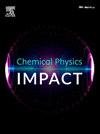The temporal evolution of UFPs, HCHO, HONO and changes in atmospheric composition in the southeast of UK
IF 4.3
Q2 CHEMISTRY, PHYSICAL
引用次数: 0
Abstract
This study investigates the temporal evolution of ultrafine particles (UFPs, Dp < 100 nm), sub-micron particles (100 < Dp < 800 nm), and reactive gases including formaldehyde (HCHO) and nitrous acid (HONO) in southeast UK urban air. Data were collected at the Brighton Atmospheric Observatory (BAO) from July 2015 to June 2023 using high-resolution instrumentation, including scanning mobility particle sizers and condensation particle counters, alongside gas analysers and meteorological sensors. UFP number concentrations displayed distinct seasonal and diurnal patterns, with smaller particles (20–70 nm) influenced by local emissions and larger ones (70–800 nm) showing evidence of regional transport. Strong correlations (e.g., R² = 0.79 between N30_50 and N50_70) indicate sequential growth likely driven by coagulation and shared sources. HCHO peaked around midday during summer due to enhanced photochemistry, while HONO levels were higher in colder months, likely due to reduced dispersion and surface-mediated formation. Polar plot analysis revealed direction-specific pollutant enhancements, with elevated levels of NO₂, SO₂, HCHO, and HONO associated with distinct wind sectors, suggesting both local and transported source contributions. These patterns underscore the interplay between emissions, atmospheric processing, and meteorological factors. Hence, the study provides new insights into UFP behaviour and secondary pollutant dynamics in an urban coastal setting. The findings highlight the need for seasonally adaptive air quality strategies and contribute valuable evidence to support public health and regulatory decision-making.

英国东南部ufp、HCHO、HONO的时间演变及大气成分变化
本研究探讨了超细粒子(ufp, Dp <;100 nm),亚微米粒子(100 <;Dp & lt;800 nm),以及英国东南部城市空气中的甲醛(HCHO)和亚硝酸(HONO)等反应性气体。数据于2015年7月至2023年6月在布莱顿大气观测站(BAO)收集,使用高分辨率仪器,包括扫描迁移率粒径仪和冷凝粒子计数器,以及气体分析仪和气象传感器。UFP数浓度表现出明显的季节和日模式,较小的颗粒(20-70 nm)受局部排放的影响,而较大的颗粒(70-800 nm)则显示出区域运输的证据。强相关性(例如,N30_50和N50_70之间的R²= 0.79)表明序列增长可能是由凝聚和共享源驱动的。由于光化学增强,HCHO在夏季中午左右达到峰值,而HONO水平在较冷的月份较高,可能是由于分散和表面介导的形成减少。极坐标图分析显示了特定方向的污染物增强,NO₂、SO₂、HCHO和HONO水平的升高与不同的风部门有关,表明本地和运输源都有贡献。这些模式强调了排放、大气处理和气象因素之间的相互作用。因此,该研究为城市沿海环境中的UFP行为和二次污染物动态提供了新的见解。研究结果强调了季节性适应空气质量战略的必要性,并为支持公共卫生和监管决策提供了宝贵的证据。
本文章由计算机程序翻译,如有差异,请以英文原文为准。
求助全文
约1分钟内获得全文
求助全文
来源期刊

Chemical Physics Impact
Materials Science-Materials Science (miscellaneous)
CiteScore
2.60
自引率
0.00%
发文量
65
审稿时长
46 days
 求助内容:
求助内容: 应助结果提醒方式:
应助结果提醒方式:


